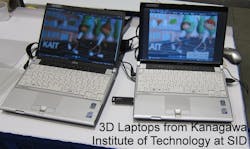By Display Central (http://www.display-central.com/)
Matt Brennesholtz of Display Central writes:
At the recent ACM conference on User Interface Software and Technology (UIST '12), Disney Research (Pittsburgh, Pennsylvania) and Carnegie Mellon University presented a paper on the production of optics for user interfaces and displays using 3D printing technology.
The phrase "3D Printing" does not refer to printing of 3D images. Rather, it refers to creating a complex three dimensional physical object directly with a printer from the CAD model of that object. No machining or tools are needed. This technology is often used to make prototypes of complex objects.
3D printed optics typically involves a transparent photopolymer that is deposited in layers and then exposed with UV light to polymerize it in the regions desired by the designer to be solid. This exposure can be either by a projector or by a scanned UV laser [a process called "laser additive manufacturing" or "laser sintering"].
According to Disney, "3D printing is rapidly expanding, with optical-quality transparent plastic, deformable 'rubber', and biocompatible polymers available on the market. In this work we used an Objet Eden260V 3D printer and Objet VeroClear transparent material to fabricate optical elements. VeroClear has similar optical properties to Poly(methyl methacrylate) (PMMA), commonly known as plexiglas, with a refractive index of 1.47 (650nm light source)."
Multiple materials can be used in one printed object, including both clear and colored materials. In addition, pre-fabricated optical elements or sensors can be embedded into a 3D printed object.
To find out more about Disney's research, read the full story HERE.
SOURCE: Display Central; www.display-central.com/flat-panel/disney-uses-3d-printed-optics-for-displays/
IMAGE: Disney is not the only company using 3D laser printing to fabricate clear and colored objects; Insight Media saw lenticular arrays for integral imaging and autostereoscopic 3D displays at SID 2012 that had been made with 3D printing techniques that were fabricated by the Kanagawa Institute of Technology and presented in SID poster paper P-1. (Courtesy Display Central)
